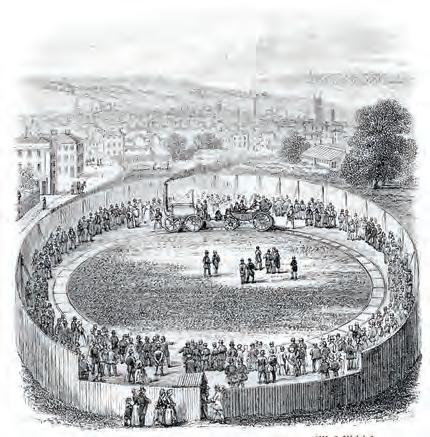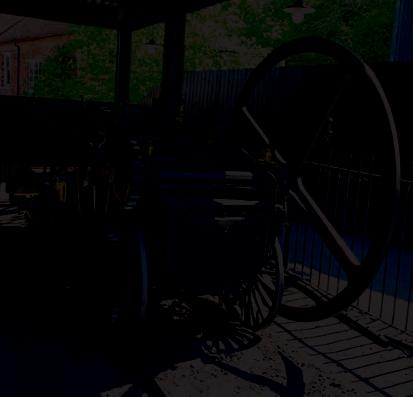BeforeRocket

3
Thesteam locomotiveup to 1829
AnthonyDawson
Acknowledgements
Inwritingthisbook IwouldliketothankAndyMasonforhiscontinuedsupportofmy writingendeavoursandforhisaccompanying me onvariousresearch expeditions. Ishould alsoliketothankAndyGuy,co-ordinatoroftheEarlyRailwaysGroupoftheRailway &CanalHistoricalSocietyforpeerreviewofthistext,andforhisclarifications.Sotoo SheilaMiddleton,archivistoftheMiddletonRailway Trust.Thankstootothesupportand friendshipoftheRailway VolunteersattheScience&IndustryMuseum,Manchesterand theNationalRailwayMuseum, York.
Unlessstatedotherwise,alltheimagesareby theauthororfromhiscollection.
FirstpublishedinGreatBritainin2020
byGresleyBooks
animprintofMortonsBooksLtd.
MediaCentre
Morton Way
HorncastleLN96JR
www.mortonsbooks.co.uk
Copyright ©GresleyBooks,2020
Allrightsreserved.Nopartofthispublicationmaybereproducedortransmittedinanyformorbyany means,electronic ormechanicalincludingphotocopying,recording,oranyinformationstorageretrieval systemwithoutpriorpermissioninwritingfromthepublisher.
ISBN978 1911658252
TherightofAnthonyDawsontobeidentifiedastheauthorofthisworkhasbeenassertedinaccordancewith theCopyright,DesignsandPatentsAct1988.
Typesetby ATGMedia
PrintedandboundinGreatBritain
10 987654321
4
5 Contents Why replacethehorse? 6 Chapter 1–Richard Trevithick1802-1814 7 Chapter 2–BlenkinsopandMurray1811-1815 20 Chapter 3–Mechanicalhorsesandsteamelephants32 1812-1822 Chapter 4– Billies and Dillies at Wylam1814-1816 42 Chapter 5–GeorgeStephenson1814-1825 54 Chapter 6–RobertStephenson &Co.1823-1829 70 Chapter 7–Goingin adifferentdirection –91 HackworthandRastrick1824-1829
Why replacethehorse?
TheRainhill TrialsofOctober1829 werethecomingofageoftherailway locomotive.Before aconcourseofan estimated10,000spectators,thelocomotive demonstrateditssuperiorityoverusing horses,orrope-haulage via stationaryengine.
Butthelocomotivewasnotnew:itwas aquarterof acenturyold.Thisbookcharts thedevelopmentofthelocomotiveuptothe deliveryof Rocket byRobertStephenson& CoofNewcastleinSeptember1829;charting howitevolvedfromthelumberingcuriosities ofRichard Trevithick’s firstpioneering attemptsto amachinewhichcouldbefound atworkacrossthenorthofEnglandand alsoinEurope.
Butwhyreplacethehorse?Between1792 and1815Britainwasalmostconstantlyat warwithRepublicanFrance; awarwhich wasnotnecessarilypopularandonewhich droveupthecostoflivingformany.
Itwasalsothestartoftheindustrial revolutionwiththemechanisationof,in particular,theclothindustry.Employers werelookingtowardmachinestoincrease productivityandreducecosts.Thesteam engine –asdevelopedbyMatthew BoultonandJames Watt –haddriventhis transformation,and atransportrevolution wastakingplacewiththeconstruction ofcanalsandnewturnpike roads.Theprime moveronroads,canalandindustry(including collierywaggonways)wasthehorse,but theNapoleonicwarshadledtothecostof horsesnearlydoublingduetodemandfrom themilitary.
Furthermore,thecostoftheirfodder wassteadilyrising,withpricesforhorses andcornreachinganall-timehighbetween
1812and1814.Thiswasinpartduetobad harvests,butalsodemandfromthemilitary tofeedthearmy.
Furthermore,aspartofthewareffort againstFrance,therewasalso aheavytaxon horses.Thustheintroductionoflocomotives reducedtherelianceuponhorses(and expensesassociatedwiththem);reducedthe numberofemployeesandthuslabourcosts; andreducedtransportationcostsbecausea singlelocomotive(despiteitshighinitial cost)couldmove agreaterloadthan ahorse, requiredfeweremployeestomanageitand couldburncheapcoalfromtheminerather thanexpensivecornandhay ahorserequired.
Itisnotsurprisingthatcollieryowners andmanagerssuchasJohnBlenkinsopin Leeds,ChristopherBlackettat Wylamorthe GrandAlliesatKillingworthallbegantheir locomotiveprojectsaround1811-1812when thecostofhorses,foodandlabourwereat theirhighest.1 Thepricesofhorsesdropped dramaticallywithcessationofhostilities duetoreduceddemand,butprimarilyfrom themarket being flooded withformerarmy horsessoldat‘rockbottom’prices.
Thereductioninthecostofhorsesfrom circa1815tocirca1824resultedinmany givingupexperimentswiththelocomotive, butthelikesofGeorgeStephenson, William ChapmanandJohnBuddlethoughttheywere worthperseveringwith.Therewasanother spikeinthecostofhorsesfrom1824-1825, andagain1827-1828whichinspiredfurther phasesoflocomotivebuilding.2
6
richard Trevithick 1802-1814 Chapter1

Richard Trevithick(1771-1833), the‘CornishGiant’,isgenerally consideredtohavebuiltthe first steamlocomotive. Trevithickhadbeena pioneerofusing‘strongsteam’usually around50psi,comparedtothelowpressure condensingenginesofBoultonand Watt. Byusinghighpressuresteam, Trevithick wasabletodevelop acompactyetpowerful steamplantsuitablefor avarietyoftasks.

Hewasalsoquicktoappreciatethat ahigh pressureengine,ifbuiltsufficientlylightly, couldbecomeself-moving.Hebuilthis first
roadcarriagein1801andhisLondonsteam coachin1803,butwhiletheydidwork,they wereimpracticalduetothepoorstateof theroads.
Thus,itwasnaturalthathewouldthenturn hisattentionto aself-movingsteamengine onrails.Thenumberoflocomotivesactually builtby Trevithickisdisputed,andasJim ReesandAndyGuyarguedin2003,whether theywereintendedtobelocomotivesper-se orsomethingmoreakinto a‘steamSwiss armyknife’, aself-movingsteamengine capableof ahaulingloadsbutalsobeing abletotorunstationarymachinery,isopen todebate.3 ReesandGuyposited alistof fivelocomotiveswhichweredefinitelyby Trevithick(Penydarren;Gateshead;Catch MeWhoCan; WestIndiaDocks;Plymouth Breakwater)and fivepotential or ‘derived’ Trevithickdesignswhichincludethe Coalbrookdalelocomotive,reputedtobethe world’s firststeamlocomotive.4
Coalbrookdale1802
Trevithick’s firstlocomotiveisgenerally consideredtohavebeenbuiltin1802for theCoalbrookdaleCompany,ownedbythe Quakerironmaster WilliamReynolds.The problemis, Trevithick’sownstatement of August1802merelyrefersto‘acarriage... forthereal-roads’.Thereisevidencethat castingsweremadefor asteamengine andthat Trevithickwaspaidfortestinga pumpingengine,butthatdoesn’tnecessarily
7
ABOVE: RichardTrevithick,the‘father’ofhigh-pressure steamandthe railwaylocomotive.
meanthatitwas alocomotive.Beingsofar removedintime,itisnotpossibletoconfirm itwasevercompleted.5 ThusasReesand Guyconcluded:‘Itmaynothavebeensteam, maynothavebeen alocomotiveandmaynot havebeen aTrevithickengine’,notingthat MatthewMurrayofLeeds(Chapter2)has alsodesignedandpatented aportablehigh pressuresteamengineatthesametime. 6

Recentresearchthrowsnewlightonthe situation.Theenigmatic‘TramEngine’ drawingdatedDecember1803,whichhas traditionallybeenthoughttorepresentthe PenydarrenEngine(despiteincompatibility ofdimensions)andlater,becauseofits3ft gauge,toshowtheCoalbrookdaleengine, insteadmayrepresent ahithertounknown Trevithicklocomotive.
The TramEnginedrawingwasfound inSouth Walesin1855,andoraltradition suggestedthattheenginehadinfactbeen builtandusedonthe‘oldnavigation tramway’ ‘aboutthesametime Trevithick
wasatMerthyr’.7 In2019aradicalnew interpretationforthe TramEnginedrawing waspresented,thatitpossiblyrepresentsa ‘lost’ Trevithickenginebuiltforthe Tredegar Iron WorksinSouth Wales,whichmayhave runonthe3ftgaugeSirhowy Tramway,part ofSamuelHomfray’sbusinessempire,which alsoincludedthePenydarrenIron Works. Thus,itispossiblethat‘Homfray,enthused by Trevithick’sprogress…persuadedhim todesign asimilarbutsmallerversionfor Tredegar’.8 Indeed Trevithicknotesthathis Penydarrenlocomotivewastoobigforthe job,andintendedbuilding asmaller, lighter one,butthiswasprobablyforHomfrayat Penydarrenratherthanelsewhere.
Penydarren,1804
Trevithick’smostwell-knownlocomotive wasthatwhichhebuiltforthePenydarren Ironworksin1804.And,asnotedearlier, despitetheappearance of theenginebeing supposedlywell-known,the1803drawing

8
1.RichaRdTReviThick1802-1814
ABOVE: Trevithick ‘TramEngine’drawingofDecember1803:oncebelievedtodepictthePenydarrenlocomotive, furtherstudysuggested agaugeofonly3ft,withsuggestionsthatit representedthetentativeCoalbrookdale Locomotiveoranas yetunknownlocomotiveinSouth Wales. (Science & Society Picture Library)
whichistraditionallysaidtorepresentthe enginedoesnot.

Furthermore,giventheverylimited clearancesofthePlymouth Tunnelonthe Penydarrentramroad, alarge flywheeland tallchimneysimplywouldnot fit,ruling outthe TramEngineandthe‘Gateshead’ enginedesigns.
The TramEnginedrawinghasthe cylinderandcross-headarrangementatthe sameendasthechimney.Thisis avery impracticallayoutmakingtendingthe fire andcheckingwaterlevelsonlypossible whenthelocomotivewasstationary,andis perhapsbettersuitedto astationaryengine whichwasusedintermittentlyandwhich couldbetendedtowhilenotinmotion.
Giventhat TrevithicksaidthePenydarren
enginewasverymanageable,andthatDavies Giddynotesitwasbuilttobeconvenientfor thedrivertoworktheengineandforthe
ABOVE: Aworking replicaofthe‘TramEngine’ wasbuiltatIronbridgeMuseumin1990,purportingto represent the‘carriage…forthe real roads’mentioned by TrevithickinAugust1802.The replicaisoccasionallysteamed atBlistsHillVictorian Town,partoftheIronbridgeGorgeMuseum. (Matthew Riccheza)

9
ABOVE: Thepreciseformofthe1804Penydarrenlocomotiveisunknown,butit wasprobablysimilartothe1805 Gatesheadlocomotive.This working replica wasbuiltin1981 by theWelshIndustrialandMaritimeMuseumin CardiffwithhelpofNCBapprentices.ItisnowondisplayattheNational WaterfrontMuseum,Swansea.


10
1.RichaRdTReviThick1802-1814
witnessestoseewhatwasgoingon,this wouldprobablyruleoutthecylinderbeingat thesameendasthechimney.Thus,itismore likelythatthePenydarrenlocomotivehadthe cylinderattheoppositeendtothechimney and firebox,somewhatanalogouswiththe GatesheadEngine(oppositebelow)which isthesubjectof areplicaattheNational WaterfrontMuseuminSwansea.9
WhatisknownaboutthePenydarren engineisthatithadfourwheels; acast ironboilercontaining awrought-iron flue; arolledironchimney;and asingle cylinder 8½ inchesboreby4ft6instroke andthatitweighedabout fivetons withoutwaterintheboiler.Itsactual configurationisunknown,butGuyetal havepresented atentativereconstructionof theenginebasedonknowndimensionsand Trevithickpractice.10


11
Oneofthemostimportantobservations aboutthePenydarrenlocomotiveis regardingtheeffectofexhauststeaminthe chimneyonthe fire.Despite alengthyand oftenacrimoniousdebateinthepagesofthe technicalanddomesticpressduring18571858 –dubbedthe‘BattleoftheBlastpipe’ –itisevidentthatRichard Trevithick firstobservedandunderstoodtheprincipal oftheblastpipeonhis1804locomotive: ‘The fireburnsmuchbetterwhenthesteam goesupthechimneythenwhentheengine isidle’,andlaterreinforcedthepoint‘it makesthedraughtmuchstrongerbygoing upthechimney’.Thiswasanobservation sharedbyothers,includingDaviesGiddy whoremarked:
Everyonelookedasattentivelyas possibleintothe fire-place;whiletheengine movedattherateof afewstrokesa minute;andallagreedindeclaring, thatthe firebrightenedeachtime thesteamobtainedadmissioninto thechimney,astheenginemade itsstroke.11
Itisalsoworthnotingthat Trevithick alsodischargedtheexhauststeamfromthe cylinderofhisstationaryenginesintothe chimneyaswell.Theybecameknownas ‘puffers’fromthedistinctivesoundthey madefromtheexhauststeaminthechimney. As EL Ahronsputitin1927:‘Theeffect [oftheblastpipe]wasthereinnature andquality.’12
Trevithick’sotherbreakthroughwasthatof adhesion.MajorNicholas-JosephCugnot’s (1725-1804)steamcarriageof1770had showntheviabilityofanadhesion-worked steamvehicle,albeitontheroadratherthan rail.Notonlydid Trevithickobservethata smoothwheelonanironrailhadsufficient adhesiontopropeltheengine(and auseful load)hetesteditalso:
Thereisnodoubtaboutthewheels turningroundasyousuppose,forwhenthat enginein Walestravelledonthetramroad, whichwasverysmooth,yetallthepower couldnotsliproundthewheelswhenthe enginewaschainedtothepostforthat particularexperiment.13
Aswithunderstandingtheroleofexhaust steaminthechimney,claimshavebeenmade that Trevithickdidnotcomprehendadhesion, particularlybecausehis1802patentstates ‘wedooccasionally,orincertaincases,make theexternalperipheryofthewheelsuneven’ tohelpthewheelsgrip.Theoperativeword is‘occasionally’,butthereisnoevidencethis waseverutilised.Despitethis,supporters of WilliamHedley(Chapter4)claim he wastheprogenitoroftheadhesion-worked locomotive,eventhoughHedley’spatent (1813)made asimilarclaimas Trevithick aboutmakinghiswheelsroughforthe purposeofadhesion –andusing arackand pinion(likeBlenkinsop(Chapter2))orevena chain(àla ChapmanandBuddle(Chapter3)) toimpelthelocomotiveforward,particularly ongradients.14 Althoughheneverbuilt suchanengine, Trevithickalsodeservesthe creditfortheuseoftwocylindersworking cranksset90ºapart,bywhichmeansthe actionoftheenginebecamemore‘equable’ and‘it[became]unnecessarytoloadthe workwitha fly[wheel].’Thiswasanother crucialbreakthroughinthedevelopmentof thelocomotive.
Crawshay’s wager
ThePenydarrenenginewasfamouslythe subjectof a500guineawagerbetween SamuelHomfrayandRichardCrawshayas towhetheritcouldtake aloadoftentons downthefulllengthoftheline,accompanied byonly asingleman,andthenreturnwiththe empties.Thetriptodecidethebetwasmade
12
1.RichaRdTReviThick1802-1814












